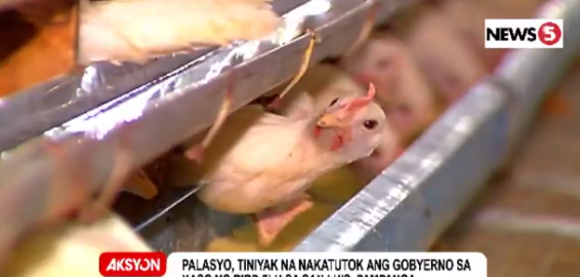MANILA – Authorities began at the weekend the culling of thousands of fowl in Barangay San Carlos in San Luis town in Pampanga a day after the Department of Agriculture announced a bird flu outbreak.
Workers wearing hazard suits entered the quarantine area in a poultry farm Saturday to begin the grim task of killing, and then burying the chickens.
According to veterinarian Arlene Vytiaco, national avian influenza focal person, the poultry animals must be quickly disposed off to prevent these from leaving the quarantine area.
A back hoe dug up the burial place for the fowl near the poultry houses.Each farm has a designated mortality pit.
“Our method of disposal is through burying. It’s not enough to just dig up holes. There’s a strict specification: it must be at least 6 feet deep,” said Vytiaco, partly in Filipino.
The birds for culling are put in sacks, which are then placed inside containers and gassed with carbon dioxide until they die.
Vytiaco said all items used in the operation must be disinfected. The feeds used in the affected poultry farm will be buried along with the fowl.
Once a poultry house is emptied, it then becomes the focus of massive disinfecting.
Only chemicals safe for people will be used in the operation, she added. “We must use safe disinfectants because we have to consider their set-up: the farms are usually near the homes of people.
The goal is to finish burying the affected fowl in three to five days, after which the workers involved in the culling process undergo 10 days of quarantine.
The national avian influenza task force will set up observation points in poultry farms within the 7-km radius to ensure the virus does not spread.
Authorities estimate that poultry growers will have to wait 3-4 months before they are allowed to resume operations.
Poultry growers, meanwhile, are asking the government for help as they grapple with the economic fallout. Linda Sumat, poultry owner, said: “Sana sa gobyerno…matulungan kami, malaking bagay na sa amin ‘yun kasi di biro sa amin ang nangyari. Nakakaiyak talaga [We hope the government helps us. That’s important, because what happened to us is no joke. It really makes me cry].”
She said authorities initially promised to compensate them at the rate of P80 per head, and they hope this could go higher.
For the moment, the poultry growers are relying on growing some crops as an alternative source of income.
Is it really bird flu? Ex-mayor doubts
Meanwhile, a former mayor of Candaba town nearby echoed an agriculture sector leader that the government should have held off from declaring the avian influenza and waited for the result of confirmatory tests from Australlia.
Candaba hosts the swamplands that attract migratory birds and draw tourists and bird watchers from around the world.
Ex-mayor Jerry Pelayo doubted that the virus that killed thousands in the farm in San Luis town is avian influenza, which he noted is not known to survive in hot places. “The migratory birds from, say, Siberia, Australia and China cannot reach the Philippines if they are ailing, said Pelayo, who was Candaba mayor for nine years, and developed the area as a hub for bird-watching.
He noted as well that the fowl in San Luis started falling ill in April. “The [migratory] birds come here in October, when it’s cold in their countries. They return home when the cold is gone.”
Meanwhile, he wondered aloud why authorities scuttled the interagency Task Force Iwas Bird Flu, which he said was a key factor in the Philippines’ remaining as the only bird-flue-free place in Asia for many years.
It also helped, he said, that an executive order issued by then President Gloria Arroyo had banned the importation of Peking duck, precisely to avoid bird flu infections, considering the high incidence in China.
The Peking duck in the Philippines is raised mostly in Victoria, Laguna, said Pelayo, though other officials had earlier said that rampant smuggling of Peking duck from China might explain the current outbreak.
Pelayo also held out as one possibility the virus source came from quail or chickens imported by local breeders.
As for his doubts that it may not even be bird flu in the first place that is causing the Pampanga birds to fall ill, Pelayo said in an interview with DZMM that perhaps another kind of virus is involved.
He echoed the position Friday by Rosendo So of the agriculture industry group that the DA should have awaited more confirmatory tests before making the announcement.








